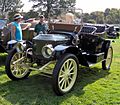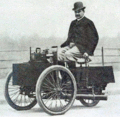Steam car facts for kids
A steam car is a type of car that gets its power from a steam engine. Imagine a tiny train engine, but in a car! The very first car ever made was actually a three-wheeled vehicle that ran on steam.
Contents
The Story of Steam Cars
Early Steam Cars
The idea of a car powered by steam started a long time ago. In 1769, a French engineer named Nicolas-Joseph Cugnot invented what many call the first steam carriage. It was a big, three-wheeled vehicle. This early car used coal to heat water and create steam in a boiler. The boiler was placed at the front, which made the vehicle a bit wobbly and unstable.
Steam Cars Become Popular
Around the time of the American Civil War in the United States, many inventors started working on their own steam-powered cars. In England, around 1868, J. H. Knight designed a very good steam car. Later, in 1883, Jules-Albert de Dion and Georges Bouton in France also began building steam cars.
In the US, Ransom E. Olds started making steam cars in 1886. Then, in 1899, two brothers, Francis and Freelan Stanley, began making their famous Stanley Steamer cars. These cars became very well known.
How Steam Cars Worked
Good Things About Steam Cars
Steam engines in cars had a lot of torque. This means they had a lot of twisting power, which helped them speed up very quickly. Because they had so much power at different speeds, they didn't need a gearbox like modern cars. They could also carry heavy things easily.
Controlling a steam car was simple: you just used the throttle to go faster or slower. The engine would almost never stall or stop suddenly. Steam cars also had fewer moving parts than cars that ran on gasoline. Plus, they were very quiet!
Challenges for Steam Cars
One big problem with steam cars was that they took a long time to "fire up." You had to wait for the boiler to get hot enough to make steam, which could take up to 20 minutes before you could drive. In winter, the water in the car could freeze, which was another issue.
Also, early steam cars couldn't travel very far without needing more water. The water turned into steam and then was lost out of the exhaust. Later, steam condensers were added to these cars. These devices turned the steam back into water so it could be reused. However, these improvements came too late. By then, cars with gasoline (and diesel) engines had become much more popular and easier to use.
Related pages
Images for kids
-
Stanley Steam car (1912)
-
The engine of a Locomobile Steam car
See also
 In Spanish: Automóvil de vapor para niños
In Spanish: Automóvil de vapor para niños













